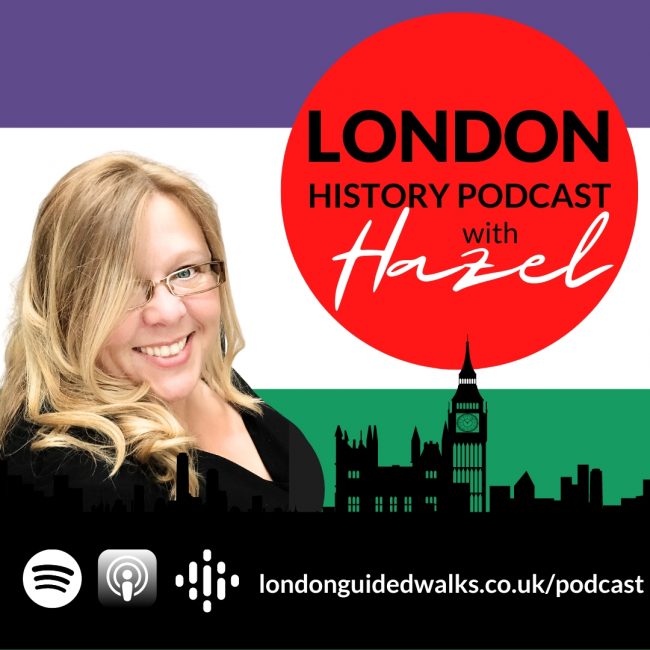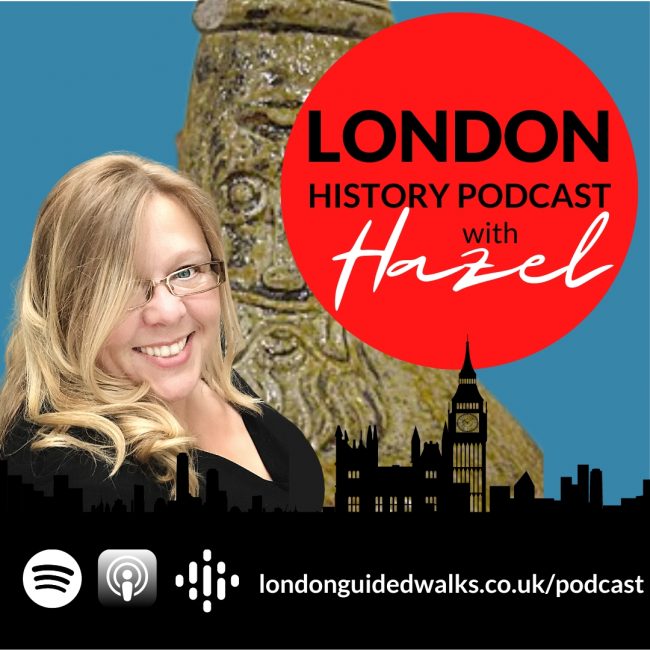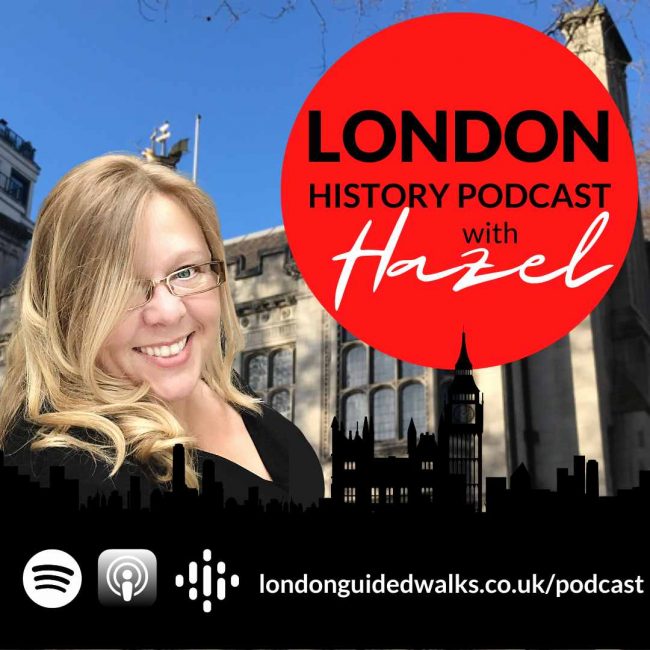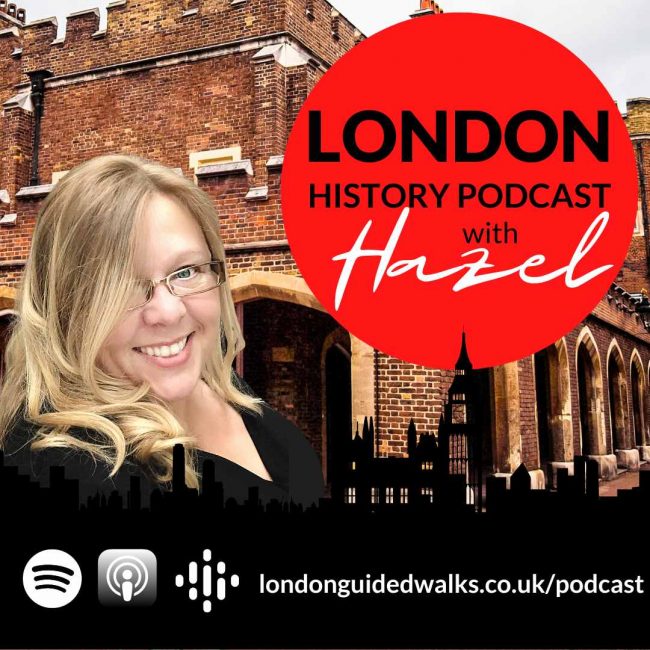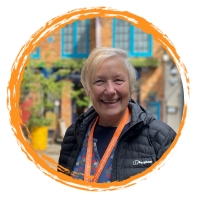
Sylvia is an enthusiastic lover of London and its rich history.Whether leading you down hidden alleys, or encouraging you to look again at buildings you’ve rushed past a hundred times, Sylvia aims to show you London as you’ve never seen it before.
Accredited tour guide, former teacher and natural story-teller, Sylvia brings history to life through stories of lesser-known Londoners – women, trade unionists, radicals and more.
Sylvia brings natural energy and vigour to her wealth of historical knowledge which makes for a fun and memorable tour.
Book a walking tour with Sylvia
 Hazel Baker is an active Londoner, a keen theatre-goer and qualified CIGA London tour guide.
Hazel Baker is an active Londoner, a keen theatre-goer and qualified CIGA London tour guide.
She has won awards for tour guiding and is proud to be involved with some great organisations. She is a freeman of the Worshipful Company of Marketors and am an honorary member of The Leaders Council.
Channel 5’s Walking Wartime Britain(Episode 3) and Yesterday Channel’s The Architecture the Railways Built (Series 3, Episode 7). Het Rampjaar 1672, Afl. 2: Vijand Engeland and Arte.fr Invitation au Voyage, À Chelsea, une femme qui trompe énormément.
Useful Links:
Episode 121: Suffragette Annie Kenney
Transcript:
Hazel Baker: Hello Sylvia!
Sylvia MacNamara: and I’m delighted to be here to talk to you about my passion, which is the Hidden and lost hospital of Endell Street.
Basically this is a story of a hospital that was set up in the First World War. It was set up between 1915 and 1919 and Dr. Flora Murray and Dr. Louisa Anderson.
Yes, it’s a bit of a mouthful, but it’s because it’s the two names of her mother and her father. They set up Bel Street Military Hospital and they were motivated to do so. Because of their own backgrounds. So Louise’s mother, Elizabeth, Elizabeth Garrett, and then she married Anderson. She, Elizabeth was the first qualified practicing woman, [00:01:00] English woman doctor in. She practiced in London, in, in, in England, but practicing in London. And she struggled to get, really struggled to get her qualifications, but she then set up a training school for women and both Flora and Louisa qualified through that training school. But they didn’t know each other. And then Louisa. Worked in her mother’s hospital as her mother retired. So that was around about 1900. she also became very interested in the suffrage movement. So both Flora and Louisa of their time would have inevitably known about the suffrage movement. And of course, Louisa’s aunt was Millicent Garrett Fett, who had set up the first suffrage.
Movement for women. The suffragettes were more militant. flora Murray became the physician to Hurst, and both Flora and Louisa were involved in both withholding money for tax and throwing bricks through the windows of the buildings on the mal. [00:02:00] And so they were arrested and, and spent time in Holloway Prison for four weeks. by 1914. They’d met and they’d become partners and they were living together and they established a hospital together, a hospital for women and children. And along comes the first World War. Still struggling for s suffrage, of course. And, and I think it was their, by this time they’re in their forties, their 40 year olds. And I think it was their strong sense of duty that, that you know, they, they were trained doctors. Here was a war. Soldiers were being killed. wanted to volunteer their time and their, their skills. And they did actually set up the women’s hospital call, WHC, which invited other women who were already qualified to become volunteers as part of that.
And it was a sort of alternative to the the Iraq, the Royal Auxiliary Military Corps that was in existence for men. But, but anyway, they, they knew that their sisters in [00:03:00] Scotland had gone to the British Military Office and offered their services and been told to go and sit at home, basically. And they, so therefore, they decided to offer their services directly to the Belgians. And they went over to Paris on the boat train. They were waved off by Louise Louise’s mother Elizabeth had a number of friends and family, and they got there. Both excitement and trepidation, but they were welcomed with open arms for the skills that they were offering, and they were shown to the Clariti Hotel and offered that as a hospital. Louisa was quite shocked when she went down and down to the front and saw the state of the soldiers coming in because these women had never to operate on men. They were only allowed to operate on women and children. but they set two and created a hospital out of Claridges. Hotel amongst all the chandeliers and the marble.
They had operating tables and they sterilised their equipment in the fish kettles. They contacted their [00:04:00] family and did the equipment of, of crowdfunding, got money together, got friends out as nurses and, and some female doctors as well. And they got an ambulance sent out, equipment that sent out and, and, and started. And they were basically doing complex cranial operations complex stomach operations on men, which they’d never done before. They were dealing with gangrene from trench and trench foot, and all sorts of infections that background that they’d had from there. Early training, which was about sterilising equip equipment and taking an antiseptic kind of approach to medicine, stood them in good stead, and it became clear to the English military that this hospital was a success, that more soldiers were surviving in that hospital than, than in other hospitals. A bit like the Florence Nightingale story in the Crimean War. And so their attention was particularly drawn to General Koff, who was the director general in the military at the time for [00:05:00] Britain. And he invited them to come back to London and establish a hospital to, to bring the soldiers that were coming on the.
Boats the boat train into Waterloo, bring them into a hospital and operate on them there. And given that that was what they wanted to do in the first place was operate on English patients, as it were, you know, contribute to their own country, then, then they of course said yes. And kiosk found this building, which was an old workhouse building. It had been relatively recently rebuilt in the 1870s, and then closed around about 19 six. 1906. So it was vacant and he went round it and thought, right, this’ll do, this’ll do the job. And when one of the military of the Royal Auxiliary military Corps people, the the Iraq peoples that this was going to be converted into a hospital run by women. He said, God forbid women, the, their reaction was pretty powerful.
Hazel Baker: worse.
My [00:06:00] goodness. So they had to do a lot to prove themselves before , the British men would give them any time a day.
Sylvia MacNamara: And they decided that that’s what they would do. They would really prove themselves what they felt. And what they knew was that they had developed a certain amount of not just expertise, but toughness resilience, as we would call it today by. Running that hospital in free, it was about for 15 months, they ran the hospital both in Paris in that CLA hotel, but also for three or four months in Wio nearer the front. and so they’d seen a lot of the sorts of, problems that they would encounter. But the numbers were phenomenal, really. You know, that they, they had a 500 bed hospital that they established in that in that workhouse it was extended to 570 beds in the end. And up to 80 soldiers at a time were received and taken up to the theatre and they were performing up to 20 operations a day.
So it was relentless. It was [00:07:00] really, really relentless. And they, were employing and training and taking on other women, doctors and women nurses. It was, they decided from the outset it was going to be a, a hospital run. By women for soldiers. So although there were some men there, they were these who kind of forced upon them by Kio, oh, you know, we’re gonna have to employ some of these as porters or security. It, it was fundamentally their hospital and they were very clear that they were the commanding officers in that hospital. And, Louisa’s kind of specialty was surgery. So she was the lead surgeon. And she would in induct the others into the, into the ways had spent a year after her initial training in America and she enrolled on a course there. And she was very influenced by a doctor who had what we would. Call a kind of bed good bedside manner. So he, he, his kind of [00:08:00] mantra was that you needed to listen to the patients. So he would both brief his colleagues as to what, what operations, what, what. were coming in, what challenges they were going to face. And then after the operation he would go down to the wards and talk to the patients about what he had done and how they were feeling, et cetera. So Louisa introduced that approach into this hospital, into this military hospital, which was really, avant-garde. It was very it was unheard of to, to run a hospital for military soldiers that was both the team on what we were gonna do and how we were gonna operate, et cetera, and then going and visiting them on the wards. And I, I think that was because they. They realized very early on in their work in Paris that shell shock was one of the major kind of issues that they were going to have to deal with and, and was influencing the ability of those soldiers to recover. So [00:09:00] the body was in shock, but the mind was in shock as well. And so that kind of just, just from a clinical point of view, going down and talking to them and listening to them on the wards was an innovation that she brought in. but, but also there were, there were other innovations. And they, those were to, to do with medicine. So she introduced a new paste.
It was called the biser for paste. And it was called the BIIP. So it was the iodine the SMUs and iodine and paraffin mixture. And it was a, it was a. It had been invented by one of the other invented, it had been kind of concocted together, if you like. And it was thought that this pace could act as a kind of antiseptic ’cause there’s no antibiotics at that time. So. septicemia was one of the most likely ways in which you were going to die. So what was really important was not just operating, but then recovery [00:10:00] afterwards and recovery in such a way that you didn’t get septicemia. So, one of the problems with the previous approach was that you had to change the bandages regularly, and every time you went to change the bandages, then the scab would kind of pull off and, and then you had to re.
Apply this pace stuff and re bandage, and that took up huge amounts of the nurse’s time. She introduced this other, this new pace, this business paste and, and, it in, in a clinical trialing kind of manner. So she tried it out with one group of soldiers, and then the other group of soldiers had the old way of doing things and she got one of the doctors to take a lead on that, the women doctors, to take a lead on that.
And, and together they wrote it up and it got published in The Lancet. But perhaps more importantly, but. What they realised quite quickly is that it worked and they could leave the bandages on for 21 days any infection setting in, and that saved time. So with these, you know, 20 operations a day and all these soldiers coming through 80 soldiers a [00:11:00] day, then it was really important to be able to spend more time on, on the other aspects of recovery. And, and as well, they were doing all, all, all kinds of, they, they were, they were trying to improve their resuscitation methods to counter the shock that the soldiers often encountered. They had ortho, they were in close contact with an or orthopedic surgeon and consultant who was developing different types of splints. And cranial surgery was in its infancy when the first World War broke out and a number of. Male consultants came down to watch Louisa do, had cranial surgery, and what they realised was that actually she was quite slight, she was quite a smallish woman and, and, and very. Lean and she had small fingers and she could get the, the, the kind of she could get in there to sort out the cranial surgery in a way that they recognised they perhaps couldn’t with their, with their [00:12:00] larger fingers. So all those sort of things that had happened during the 18 hundreds where women were finally allowed into operate the Telegraph, for example. They were allowed into the post office and they were invited in to work in the Telegraph office because they’re putting in of the plugs, they the men. Who in charge thought was very similar to women sewing their embroidery.
So they thought, oh, women will be quite good at this. You know, ’cause they’ve got small nibble fingers. And telegraphy was, you know, very much along those lines. Well, similarly, they began to realise, well perhaps there’s some benefits having women doing these sorts of operations. ’cause actually they can do these bits a bit better than we can. But all the time they were trying to make sure that it wasn’t just seen as a kind of novelty hospital. They were. Trying to make sure that they were recognised for what they were doing. We are a hospital. They, they had the “deeds, not words”, slogan of the suffragettes emblazoned over the presima arch in the entrance to the hospital.
So they were, you know, it was definitely about suffrage and we are, you know, we are fighting for the [00:13:00] vote as well. But, but it was also, we are doing a professional job here. We are doctors doing a job we happen to be women. And, you know, and by the way, women can do this. So, so all of this kind of work that they were doing was groundbreaking. And an example of this business pace was that she, she did some talks to demonstrate, you know, what, what they were doing and how successful it was. And she talked about being able to deal with an abscess on the frontal lobe of the brain of a man. So this was, this, the abscess was managed with this.
Paste. And then another who had both his legs fractured and there was pus pouring from them. And both of them, you know, lived and, and lived to tell the tail, if you like, you know, as a result of, of using this paste. And indeed the pace carried on being used. It was, it was taken on in both military medicine and ordinary medicine right through to the second World War, which was because of an. [00:14:00] That, that was about the period when antibiotics began to come in, and even today it’s used in ear noses and throat operations as, so it was groundbreaking the work that, that they were doing and, and it was so important that they found the time in between all of these exhausting operations to write it up and put it into the, so that it was recognised as a genuine piece of research.
Hazel Baker: It’s a huge achievement, isn’t it? It is breaking through the, the barriers in the first place, proving themselves. But then it’s not just firefighting, it’s looking at ways of improving through management, invention refining techniques, and then. Publishing it all as well. I mean, this is, this is mammoth stuff.
Sylvia MacNamara: it is, and I mean, what they did for the soldiers in terms of their mental health was, was equally incredible. So this focus on treating shell shock, I mean, there was a specialist place that, that some [00:15:00] of the soldiers could go to, to, to kind of have shell, she dealt with it was, which be a more kind of group therapy environment. But, but they were, pioneering in terms of the work that they were doing for the, for the actual mental health. They. They did things like they had all the walls and the walls were light. And were bright with windows painted in green. They had coloured quilts. They had homemade quilts on each of the beds, so each quilt was different. And they had screens between the beds that were painted, different colours. They had standard lamps for the patients to read, and they were provided by St. Leonard’s. School, which was the school that Louisa had gone to. So she, you know, she was constantly doing this fundraising stuff, or, or her mother and her grandmother were doing things.
I don’t think her grandmother was alive by then, but her grandmother had been good at that. And her mother was certainly good at that kind of fundraising stuff. The wards were all decorated with fresh flowers and they were replaced by volunteers. And that was led by her sister-in-Law, so her brother, Alan’s [00:16:00] wife. The courtyards were bright. Were, had bright flowers in tubs and window boxes, and they used all sorts of bits of entertainment. So they would get their fellow friends who were actors or actresses to come and perform on stage. And then they ran these sports days. So. That they would have competitions of crawling across the floor and the first person to get there got a cigarette.
And I mean, these days obviously you wouldn’t reward with cigarettes. But during both World Wars, that was the kind of, crutch really to get you through from day to day. They had the breath, best dressed war ward. Award. So, you know, the soldiers that dressed up their ward best got an award at Christmas and they were really intent on supplying the library with books.
So they were encouraging the soldiers to read, to read novels, to be read to. They had a whole kind of. Again, almost an army of women that would come and read to the soldiers, including Winston Churchill’s daughter. And it was [00:17:00] all this kind of focus on creating a homely and sympathetic environment because they knew that that would help the soldiers to, to feel more connected. ’cause a lot of the soldiers talked about the fact that they, they couldn’t really connect with. The society with London, you know, as they found it, having gone through those incredible, awful experiences in the trenches and seeing what they’d seen and seen their, their fellow soldiers
Sylvia MacNamara: up and, and bits of body parts everywhere. So to try and soothe the mind, and, and a lot of these soldiers will be waking up screaming in the night, et cetera, then they introduced all of these kinds of Activities, and they were very strong on occupational therapy. So they, they had the soldiers doing bits of embroidery and, and sewing and all the rest of it. And, and they stayed in touch. A lot of these soldiers wrote back to them years later and said, you know, can you send me some more socks? Like the ones that you we knitted when we were in the hospital or whatever, you know? It was incredible. [00:18:00] Yeah. Yeah. It was very much relationship based.
Hazel Baker: And they do say that at times of war is the catalyst for new inventions. But this is something you can imagine the, the, the conversations around, when doctors met talking about these women doctors, you know, painting the walls and fresh flowers.
What, what, what are they doing? My job, you know? But actually, especially during time war when these men, it’s probably the first time they’ve even been away from home. You know, you wanna find that sense of, of, of reconnecting with something. The reason to why you were fighting. And of course a lot of these men are gonna be going back to the front at some point as well.
Sylvia MacNamara: Yeah. I mean that, that I think must have been really distressing actually for those women doctors knowing that they were getting them better from being deeply poorly only to be sent out again. Yeah.
Hazel Baker: And was there any synergy you mentioned about the messaging over the front door Deeds Not Words , how did they.
Use the hospital to show [00:19:00] what women could achieve given the opportunity.
Sylvia MacNamara: the inside the hospital itself. As I said, the, the, the sort of mantra was you’ve gotta be better than the men. We’ve got to do better here as a group of women and we are pioneering the way, you know, it was very clear from the outset that we will be judged severely if we don’t succeed.
So we’ve gotta be the best. But they also gave. Both Louisa and Flora gave weekly lectures to young staff, educating them about women’s rights and their duties as citizens. And, and the patients themselves were constantly exposed to feminist ideas. So when these women, their friends came and read to them, they weren’t reading any odd stuff, were reading some quite, kind of tracks about why women should have the votes and you know what, what women can do really. And I think the other thing is, the other thing to remember is that, there were women on the streets doing jobs that men had done in all sorts of ways. So there were, obviously, there were women
Sylvia MacNamara: factories and you were [00:20:00] seeing them going on the trams, but the trams were being driven by women. The post was being delivered by women. The post was being sorted by women. And there are, there are photographs in the post office museum, amazing photographs of these women. Driving the royal mail carriage. So they had the horses, eight horses and they had boots, black shiny boots up to their knees, britches, these amazing kind of blazer coat things and, and there and top hats.
And there they were. In the countryside driving these royal male coaches through the villages, whereas before women weren’t even allowed to deliver the post. You know, you would perhaps see a woman trailing in Scotland because her husband was poorly and she was sort of doing the round for him, and you may see a woman behind the
Sylvia MacNamara: but fundamentally, women were doing that telegraphy that I said, and, but that was about it. So to suddenly see women doing, working in shops, you know, but doing butchering, [00:21:00] actually serving the, the customers and doing all of this work. This was the, the hospital being run by women was going alongside of that. So the, for that period, for four years, for, from 1914 through to five years, really through to 1990. Women were seen on the streets in a way that they hadn’t been seen before. tragedy is that it all closed down afterwards. and , to my mind, they had to do it all over again in the second World War. It was as if,, everyone had forgotten that women can do these things. So yes, , there was synergy and they, they certainly were very, mindful of the battle that was still on to get suffrage. And, and of course they won. , 1919 was the suffrage act, which I mean, it wasn’t full. It gave gave the vote to women who had property and who were over 35 years old and it. You know, it took another five or six years for women, all [00:22:00] women to be able to get the vote. But it overturned that kind of attitude that was there up to the first World War, was, it was not just about mean there was a lot of this at the, in the beginning, oh, well, you know, women have. Basically women have their monthlies and, and they become all emotional, so you can’t really trust their judgment. So, so Millicent Garrett Fset, when she was running the s Women’s Suffrage Movement, just believed that if they put forward the logical arguments in a logical way and kept putting petitions forward, then in the end these rational men would see sense. And of course, they didn’t. But probably the bigger reason that they didn’t get the vote before the first World War is because both parties were anxious that if women got the vote, they would vote for the other party.
So it wasn’t in their interest to kind of enable. More people to vote for the opposition. Whereas the kind of I think what, what kind of held it held the day after the war was the thought of almost rioting on the [00:23:00] streets. If they said that couldn’t have the vote and they were gonna treat them in the way that they had before the war of arresting them and putting them in prison. After everything that they’d given in the first World War. So, so yes, there was strong synergy. And I do think that they I don’t think they, maybe they didn’t even think about it. I think they assumed that this is Flora and Louisa. I think this is my own view. I think they assumed that once the war was finished, they would be able to be employed in any hospital. Regardless of whether it was for, for men , or not, they would be taken on as surgeons in, ordinary hospitals.
They wouldn’t have to work in hospitals for women and children. And of course that didn’t happen.
Hazel Baker: No, I think it’s a very different world being, at war. To then peace time where you can choose what what, what rules you want to, to live by. But in war time, , anything goes just to [00:24:00] beat the other side. There was something resonated with me what you were saying about recognition really, as a woman , you’ve got to get all of these points across.
It reminds me of that song of anything you can do, I can do better. And working in tech that I had, I’ve been, , often get said,, whatever you do, you have to do it far better than your male counterparts just to get acknowledgement of the basics being delivered. So, but there was a royal recognition that the, the hospital received.
Do you want to share a little bit about that?
Sylvia MacNamara: basically
Hazel Baker: King George V.
Sylvia MacNamara: And his wife Mary, came to visit. so Queen Mary was in an interesting person in herself. She, she was the one that encouraged, the women to send send boxes to their soldiers, to their sons, their husbands, their brothers, whatever, as part of the war effort.
And she also encouraged them to knit socks. [00:25:00] in fact, it was Mary McCarthy, who was a fantastic trade unionist went and got an audience with her via her daughter, really, princess Alexandra and said. Actually you are. encouraging women to knit socks and send them out to the front, you are undermining the jobs that many of my women. working class women do, which is piece work at home knitting and you are
Sylvia MacNamara: So they’re the ones now that the prime breadwinners because they’re men, folk are out on the front. I, I think we need to rethink this scheme. so they did. And queen Mary then encouraged them to send out cigarettes chocolate instead. Which, you know, again today with our medical knowledge and information we know wasn’t an ideal thing. But it was interesting that Queen Mary, you know, wanted to do her bit and to encourage women to do their bit, but it was very much about encouraging ’em to do it
Sylvia MacNamara: So [00:26:00] once they came, once George, the V and Queen Mary came, and they had actually laid the foundation stone for.
Louisa’s Mother, Elizabeth’s and final hospital, which is the one that you can still see. It’s part of the unison building on the Houston Road. So they knew the family, they knew the Garrett family, and it was Agnes, Garrett and Rhonda their cousin. Who decorated the inside of that hospital. And they were very impressed with the interior design. So, so when Louisa and Flora had opened their hospital,, they were kind of very keen to come, and they came in 1915. And they had,, I mean. Louisa and Flora had had a lot of journalists coming when they were in France, both French journalists and English journalists British Red Cross and other Red Cross and so on to see this hospital run by women. But the one in London was really kind of. Ground zero journalist interest and [00:27:00] and when the king and queen visited, it was even more so. So that whole thing of this is fantastic. The work that these women are doing, these soldiers are doing these, these women. Doctors are doing on the soldiers is, is just fantastic, was the kind of message that went out and the royal recognition was, was important. But for them personally, it was much more important when Emily Hurst came because, you know, she was the queen of the suffrage movement and she did come and she also said, you know, well done girls. Sadly by, by the time. Even, even when the train left for, with Louisa and Flora to go to Paris, by that time her mother Elizabeth had developed vascular dementia, so she probably did visit, but she wouldn’t really have been able to. You know, relate particularly to what they were doing. And that was quite sad, I think, for Louisa. and, and indeed, Elizabeth would’ve known what was coming because as a [00:28:00] doctor, as a medical doctor, once she had the diagnosis of vascular dementia, she would’ve known. And in some ways it was really good that she died in 2019.
So she didn’t have it that long. It’s four years, because for such an amazing mind to. All of those faculties would’ve been horrendous. So, so I think for, for Louisa, the next best thing was to have Emily Hurst visit and, and kind of give that acknowledgement of, of what they were doing. And, and I. I think as well, just having all those other I mean all the newspapers, the times they, they created their own little newspaper called the Gazette. and an occupation that they got the soldiers to be involved in. But the times and the mail and all those newspapers were reporting on how successful they, they were doing. So they did get that kind of recognition when in whilst they were, were, running the hospital, but it was afterwards that they, they, you know, they really didn’t get the recognition.
They really [00:29:00] didn’t get the support, the continuing support that they wanted and that they expected.
Hazel Baker: Well, you were talking before about the efficiency of the, the female staff. And the success there. But of course that then is reflected in the number of patients treated as well. Phenomenal number what? 26,000?
Sylvia MacNamara: it was.
Hazel Baker: 1915 to 1919. That, that’s huge numbers.
Sylvia MacNamara: And, they had outpatients and they were in, in charge of at least four other kind of substations, if you like. Yeah, I mean, there were. Thousands, literally thousands of patients treated and, and they didn’t, those patients did not forget them, and they didn’t forget their experience.
They knew that this experience was different to the experiences that, because the thing is that there were six postal deliveries a day, and those parcels were getting to the front a day and a half. The [00:30:00] postal system was amazing and all that work that the women that were running the postal system did during the First World War, didn’t just maintain it, they expanded the postal system, so the soldiers were
Sylvia MacNamara: all of their friends, all of their family, everybody, not just from the front, but when they got back into the hospital in, in London, so people would’ve known about it, you know, it wasn’t just word of mouth, it was through letters and, and in the press. They, they understood that this was something special that they, they were receiving. I mean, there were a large number of other kind of makeshift hospitals that were set up. If, if you see Downton Abbey, you know, that they set up a hospital in Downton Abbey in First World War, well, those state
Sylvia MacNamara: homes were being taken over by the Lady of the house and run as hospitals all across the country. So. So that that idea of women being involved in hospitals was kind of established and women’s [00:31:00] homes being given over to create that homely feeling was there, to actually be operated on by female doctors was unique.
Hazel Baker: One of the questions then is after all of well say the, the stress and the excitement and the pioneering efforts during the First World War peace is announced. We can now move on to this new, future men and women together, hurrah
Sylvia MacNamara: Or
Hazel Baker: or not.
Sylvia MacNamara: indeed. So get their c. Commanders of the British Empire. I actually, I think it was, I can’t, yeah, I think it was cbs. It’s either OB or cb. They’re recognized, you know, they’re dames for, for the work that they did. They don’t finish, they don’t close the hospital until 2019.
So it’s a year after the war has ended. They’re kind of allowed to, finish off as it were. But.
Does close, you know, the doors shut. A lot of the equipment was left there. And they go back to,, they kind of look at each other and think, [00:32:00] well, what are we gonna do then?
So they go back to their hospital on the Harrow Road and. hospital for women and children and kind of pick up the pieces and begin to start again. And Louisa did apply to four or five hospitals to see whether she would be accepted and they said no. You know, like nothing’s changed. no, no, no.
You, you can only work with women and children. And, and Flora gets sick. So Flora got cancer , she died in 1923. So basically they work in the hospital between 1921 and 19 19, 19 20 20, 20 21. And then they moved to Buckinghamshire in 22. she died in 1923. She was 55 at the time. She was really young. And, and Louisa I think is heartbroken, but also. Devastated that they haven’t achieved anything in terms of breaking into the men’s world of medicine. Despite [00:33:00] everything, despite the, those innovations, despite 26,000 patients, men ,
Hazel Baker: All that proof,
Sylvia MacNamara: Yeah,
Hazel Baker: public proof.
Sylvia MacNamara: And
Hazel Baker: Yeah.
Sylvia MacNamara: and support. So she doesn’t.
Hazel Baker: I.
practicing in medicine. She goes back to the family home and she she goes back to borough and she’s, she, she becomes mayor there. Her mother, Elizabeth Garrett Anderson had been the first female mayor. I mean. Along with so many other things. And Louisa kind of steps into her mother’s shoes. Her mother’s now died. She becomes mayor. She does kind of bits of good work. She helps set up other hospitals and so on, you know, as in fundraising, but she doesn’t work in them until the second World War. And then in the Second World War, she does help out at her mother’s old hospital, the, the hospital of women down on the Houston Road. And, but she died in 1943. She died in Brighton. So there’s a, there’s a plaque. Burial of Flora Murray is in Penn, in the Churchyard in Penn, and there’s a plaque there that’s a [00:34:00] tribute to Flora from Louisa. And Louisa’s ashes are in Brighton. But you know, I think her spirit is there in Penn, in Buckingham ship and really the legacy you know, people had to uncover the legacy. So you know, if people wanted to. more obviously come on my walks, you know, the, the Women in Medicine walk or A Tale of Two Slums, walk and share it with me as we go round.
But you know, the building’s no longer there because it’s been replaced with council housing but there’s more to read in the wonderful book by Wendy Moore. Called Endell Street, and there’s lots of kind of detail about individual nurses, doctors, and soldiers lives in in that book. But really, unless you know a bit about it, you’re not aware. I don’t think, I wasn’t aware until I came across the plaque and thought, what’s this? And, you know, it’s, that is sad. I think, you know, [00:35:00] there should be like a Netflix film about this.
Well, I’ll just forward this podcast episode to the producers, see what they can do. Yeah, it’s, it’s, it’s, it’s, it’s a sad and also a happy story about what they were able to achieve for themselves. They, they understood their limits and they pushed those. And yeah, I mean, feeling that everything you’ve achieved and proven and not being able to get through that final curtain must have been really quite heartbreaking, especially when you’re losing your, your partner.
As well, just lost, lost the will to, to fight really. But the fight continues even now in order to, to share these stories. Your Tale of Two Slums, which is around St. Giles, I’ve now done twice. Loved both times. Learned a lot. And it does show you how things are changing on a [00:36:00] gradual basis , your Women and Medicine in Euston and Fitzrovia walking tour tell us a little bit more about that.
Sylvia MacNamara: I start with Elizabeth Garrett Anderson’s Hospital and, do some backstory about her. And then we go down to look at the statue of Louisa Aldrich brandis who. I’ve also written a, a little blog on and there’s a statue of her there. She was the dean of the London Women Women’s Medical Training School after Elizabeth Garra Anderson. We go past the cruciform, which is now the Wolfson PhD Center, which is the hospital that was UCLs Hospital. And that’s where Agatha Christie did her. Second World War experience has an having trained at the same apothecary route way that Elizabeth Garrett Anderson had. And then we wander over to Fitzrovia where I tell the tale of James Barry, who was. A woman who became a man and was a practicing doctor for 40 years, would you believe? And, [00:37:00] and no one ever realized. And then we work our way back down past some amazing new buildings to the, the Cleveland Workhouse and we end at the wonderful Fitzrovia Chapel, which, wonderfully is still there, which is the chapel of the hospital. So, so UCLH is the combination of U University College, London Hospital and Middlesex Hospital. That big green and white building that you can see when you come out of Houston Station and, and one of the. The facts that I like to share with my groups is that I counted up how many women consultants there were in 2023, and it was basically a third, a third of the total number of consultants were women, so it still isn’t 50%. And I feel that Louisa and Elizabeth would both be a little bit sad that we’re. We’re not there yet. On the other hand, it’s only just over a hundred years since we had the votes, and it was only in, I think it was [00:38:00] 1976 sort of time that rape in marriage was declared a thing. And so, you know. Violence against women is a relatively new thing.
Were only allowed to be awarded their degrees at Cambridge in 1946, which was after we had color television. So, it’s relatively recent that we’ve had a lot of these developments, and it’s relatively recent that Louisa and Flora were pioneering their work as female doctors operating on soldiers.
Yeah.
Hazel Baker: Well, Sylvia, thank you very much for that. For those who are interested in learning a little bit more, I’ll put the links to both the, the book and also Sylvia’s blog post, and also links to both of her walks. A Tale of Two Slums in St. Giles and also Women in Medicine in Euston and Fitzrovia.[00:39:00]

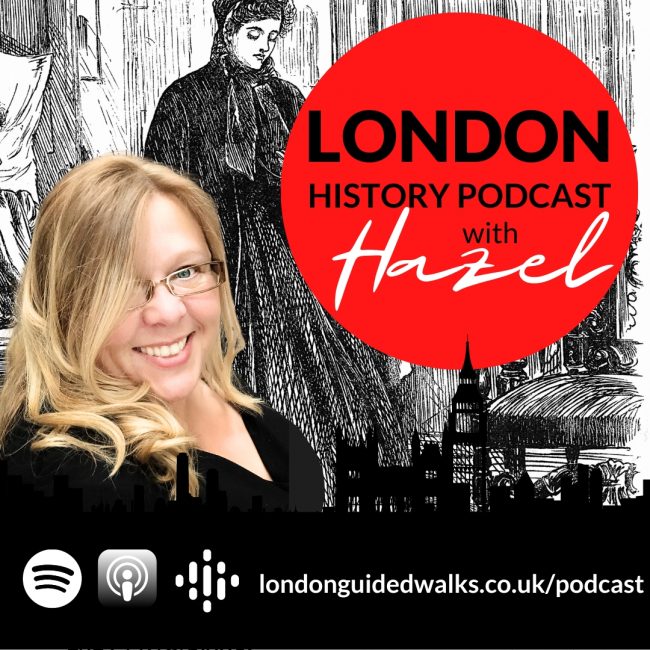

 Hazel Baker is an active Londoner, a keen theatre-goer and qualified
Hazel Baker is an active Londoner, a keen theatre-goer and qualified 
